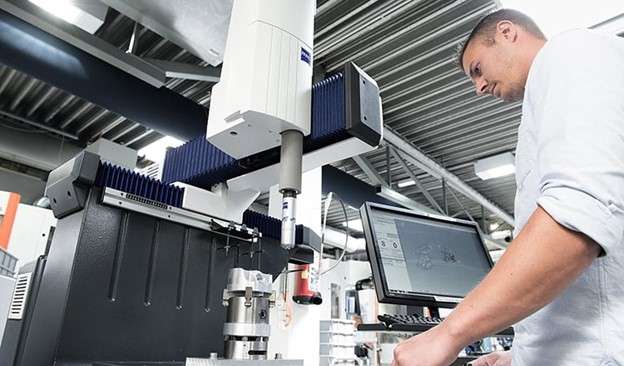
Integration of metrology in CNC manufacturing
Metrology has a significant role in precise manufacturing. It provides the theories, concepts, equipment, and coordination for measuring different dimensional features and other properties.
Conversion of the workpiece into the desired shape involves various steps, design, machining, and measurement. The acceptability of any manufactured item is evaluated by different measurements that ensure whether the item fits the required application.
This article will discuss the concept of metrology, its significance in manufacturing, and various measuring instruments in depth.
What is Metrology?
In a broad spectrum, metrology refers to measurement science. It covers the design, development, and execution of measurement devices. It has significant applications in engineering manufacturing, scientific research, and many other sectors.
Tolerances are the fundamental parameters for ensuring the dimensional accuracy of manufacturing parts (RAGHAVENDRA, 2013). Metrology defines tolerance, precision, accuracy, uncertainty, and all these terms.
Let’s understand these terms, what they mean, and how they relate to manufacturing.
Tolerance
In metrology, tolerance is defined as the “deviation of dimension parameter from standard or specified value, which is acceptable.” The tolerance is represented in terms of a plus or minus value. For example, a tolerance of ±0.01 mm means the part can be up to 0.01 mm larger or smaller than the standard or desired-specified size.
In manufacturing, tolerance is crucial since it affects the quality and functionality of the manufactured parts or products. The suitable tolerances guarantee that the part fits and functions together as intended. It cannot function correctly or fit with other components as intended if a part is outside of the required tolerance range.
Accuracy
Accuracy is a metrological parameter that indicates how close the average of actual values is related to the standard or desired value. In manufacturing, it shows the difference between the exact dimension, shape, and other characteristics to respect to the CAD model.
Manufacturers used several metrological tools and techniques to ensure accuracy. Precision measurement instruments, inspection procedures, and quality control processes are the parts of ensuring accuracy. These tools and procedures help to ensure that the parts meet the necessary specifications and standards.
Precision
The precision refers to the closeness of actual values (measured by instruments) to the arithmetic average of those values. It is generally expressed in standard deviation (𝜎).
It serves as a gauge for manufacturing process uniformity. For instance, consecutive measurements of a part’s dimensions or other properties will provide values very near to one another if the item was manufactured with high precision. Conversely, if a part is produced with poor accuracy, subsequent measurement gives wildly different values.
Importance of Metrology in Manufacturing?
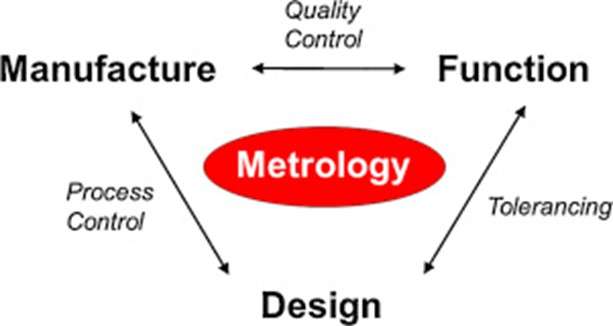
Relation of metrology and manufacturing
With the evolution of advanced manufacturing, metrology has significantly contributed to making it a more precise and accurate process. Without metrology, precise manufacturing is almost impossible. Fundamental science & technology of metrology works together with manufacturing processes to create the parts according to the specific requirements.
The Theoretical drawing or CAD model consists of several metrological parameters, such as tolerances, surface roughness, accuracy, and precision. These parameters are used throughout the manufacturing process. It allows the creation of the parts according to the requirement and specifications mentioned in the drawing.
1. Verification of raw material dimensions
Verifying the dimensions of raw materials is an essential step in the manufacturing process because the raw materials’ dimensional accuracy will affect the finished product’s accuracy. If the raw materials are not the correct size or shape, it can lead to problems downstream in the manufacturing process and result in defective products.
To verify the dimensions of raw materials, manufacturers use various metrology tools and techniques, such as calipers, micrometers, and coordinate measuring machines (CMMs). These tools allow manufacturers to accurately measure the dimensions of the raw materials to ensure that they meet the required specifications. If the raw materials do not meet the specifications, manufacturers may need to reject them or adjust the manufacturing process to account for the discrepancies.
2. Maintaining dimensional accuracy and repeatability.
In prototyping and mass-production processes, repeatability is crucial to creating parts with dimensional consistency. It is only possible with regular measurement and identification of flaws.
Repeatability ensures that the finished products meet the required specifications and are high quality. Inaccurate or variable dimensions can lead to problems downstream in the manufacturing process, such as poor fit or function of the finished product.
Various metrology tools and procedures are used to maintain dimensional accuracy and repeatability. Manufacturers also use process control techniques, such as statistical process control (SPC), to monitor and control the dimensions of manufacturing parts or products.
3. Identification and troubleshooting of problems
Identifying and troubleshooting problems in the manufacturing process is another aspect of metrology. These problems can cause defective products, production delays, and increased costs. By identifying and troubleshooting these problems, manufacturers can improve the efficiency and effectiveness of their production processes. Manufacturers can prevent these issues and improve the overall quality and reliability of products by identifying and troubleshooting problems early on.
Manufacturers can use troubleshooting methods, such as root cause analysis and hit-and-trial, to find the cause of a problem and solve it. By using metrology to identify and troubleshoot issues in the manufacturing process, manufacturers can improve the efficiency and effectiveness of their production processes and produce higher-quality products.
Metrology and related equipment can detect early defects, improve process control, and facilitates preventative maintenance (What is Metrology and Manufacturing Technology? 2022).
4. The economic advantage of metrology in manufacturing
Metrology is not only related to manufacturing in terms of quality control. It also contributes to the cost-control of a manufacturing project.
Accurate measurement in manufacturing eliminates the risk of overproduction, material wastage, and the production of defective parts. Therefore, metrology ensures that parts are made to the correct specification and helps to reduce the number of defects and lower their production costs.
5. Role of metrology in research and development
Metrology helps researchers and engineers understand and improve new products and processes by accurately measuring their key characteristics.
For example, a company making a new heat sink will measure its heat discharge, flow rates, required energy, and other characteristics to understand and improve its performance.
Common Metrology Equipment in Manufacturing
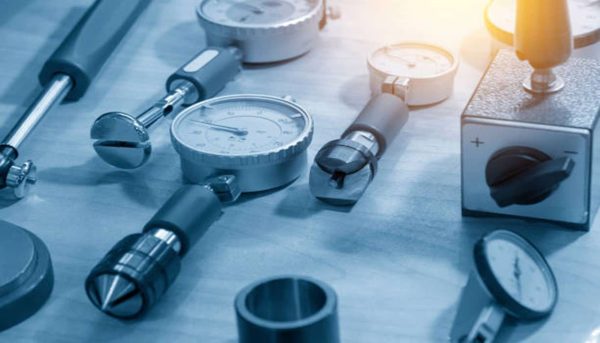
Measuring instruments
Several metrology instruments are used in manufacturing to measure the dimensions, features, and properties. Let’s discuss some of them in detail.
Calipers
Calipers measure linear and angular dimensions of raw material, processed parts, and finished parts. Vernier calipers, Dial calipers, and digital calipers are commonly used in manufacturing. However, the digital one is more accurate and easy to use.
Coordinate Measuring Machine (CMM)
A Coordinate Measuring Machine (CMM) is the most common measuring instrument in the manufacturing industry. The CMM is based on optical and laser measurement principles, which measure the physical geometrical characteristics. It can measure dimensions, form, position, and orientation, which helps calculate complex shapes and features.
Laser Scanning Arms
It is an advanced measuring instrument that simultaneously measures a broad range of dimensions. The laser scanning arm can automatically scan the various geometrical points and provide the required dimensions with complex mathematical calculations.
Surface Finish Testers
The surface finish of the material is measured by Surface finish testers. These devices measure the various surface finishing parameters, such as average roughness number, waviness, skewness, and more.
Other metrology instruments include;
-
- Balances and scales
- Micrometers
- Profilometers
- Height gages
- Depth gages
- Angle gages
- Thread gages
- Spirit levels
- Optical comparators
- Rockwell testers
- Tensile testers
- Compression testers
- Torque testers, and many more.
Conclusion
Metrology has a significant role in manufacturing, from simple measurements of dimensions to quality assurance of parts or products. Metrology is used in various stages of the manufacturing process, including the verification of raw material dimensions, inspection of machined parts, and testing of finished products. It is an essential component of precise manufacturing and plays a vital role in ensuring the quality and functionality of manufactured products.
ProleanTech is the on-demand manufacturing service provider for more than 50 material options. We use cutting-edge measurement instruments, such as a Coordinate Measuring Machine (CMM), to ensure quality and achieve tight tolerances. You can request a quote if you need a manufacturing service for your project. We will convert your design into reality.
FAQ’s
What is metrology?
Metrology is the science that involves the design, development, and execution of various measuring instruments.
What is tolerance in metrology?
Tolerance in metrology is the deviation of a dimension parameter from a standard or specified value that is acceptable and does not influence the functionality of parts.
How is accuracy used in manufacturing?
Accuracy in manufacturing is a metrological parameter that shows the difference between actual dimensions, shape, and other characteristics compared to a CAD model.
How is precision related to manufacturing process uniformity?
Precision in manufacturing refers to the closeness of actual values to the average of those values. It serves as a gauge for the uniformity of the manufacturing process.
Why is metrology significant in manufacturing?
Metrology is vital in manufacturing because it helps to ensure the accuracy and precision of parts and products, which affects their quality and functionality.
How is metrology used in the manufacturing process?
Metrology is used in various stages of the manufacturing process, including the verification of raw material dimensions, inspection of machined parts, and testing of finished products. It is an essential component of precision manufacturing.
Bibliography
- RAGHAVENDRA, N. (2013). ENGINEERING METROLOGY AND MEASUREMENTS. OXFORD UNIVERSITY PRESS.
- (2022). What is Metrology and Manufacturing Technology? GOODWIN University, from https://www.goodwin.edu/.

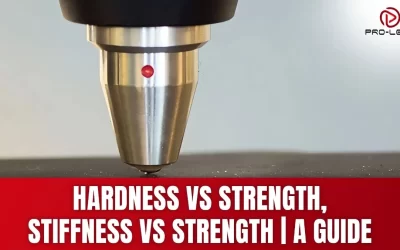
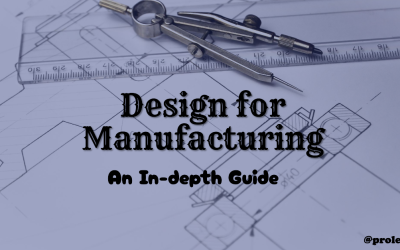

0 Comments